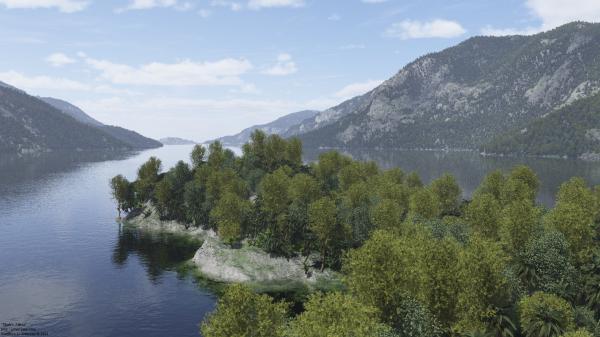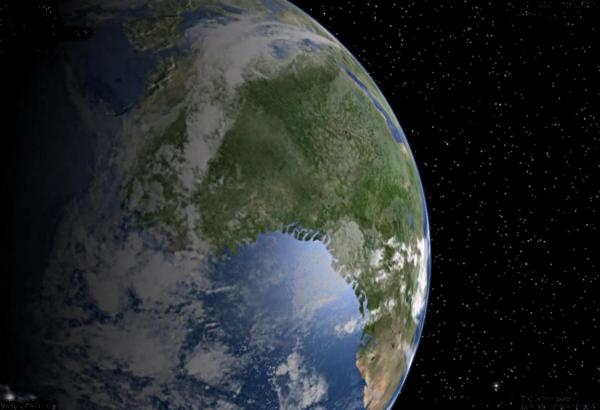BY LETTER
New Earth (104 Tauri III)
Galactography > Regions of Space > Inner Sphere
Galactography > Systems and Worlds > Systems & Worlds M - N
Galactography > Sephirotic Empires > Terragen Federation
Galactography > Systems and Worlds > Systems & Worlds M - N
Galactography > Sephirotic Empires > Terragen Federation
Capital of the Terragen Federation | |
 Image from Matthew C. Johnson | |
| The Fjords of New Africa | |
New Earth - 104 Tauri III - Data Panel | |
| Star | 104 Tauri 51.8 ly from Sol |
|---|---|
| Class | G4V |
| Luminosity | 2.5 x Sol |
| Planet | New Earth |
| Diameter | 11,880 km |
| Gravity | 0.98g |
| Semimajor Axis | 1.5 AU |
| Year Length | 1.62 standard years |
| Day Length | 22.04 hours |
| Tilt | 21 degrees |
| Allegiance | -New Earth is the capital world of the Terragen Federation |
| Ruling AI | - Yave |
Colonisation
104 Tauri (51.8 ly from Sol) was colonised in 1709 by the Tauri Development Consortium. Two of the major interstellar Megacorps, H4K and Takicorb, sponsored this project, sending a Large Colonial Autonomous Hyperturing with the designation `Jope' to oversee the project. On arrival Jope used material mined from the innermost planet to create a pair of statite power collector arrays which were suspended ten million kilometres above the poles of the local star. With an ample supply of energy, e could concentrate on the terraformation of the third planet, a tectonically inactive and eroded postgaian world.By importing water from the outer solar system the planet could be covered with shallow seas, leaving a few low-lying continents above water. Jope produced a range of alternative schemes for the restructure of these low-lying regions to form artificial mountain ranges and other physical features. The plan which found favour involved the recreation of the continents of Old Earth, with rivers, bays, islands and uplands all in place. Self-replicating nanoconstructors could achieve this transformation in less than a thousand years, and much of the planet would be habitable long before it was completed. The Development Consortium at this time gave the third planet a new name; this world would become the New Earth. Other colonies had adopted similar names- for instance Terranova and Nova Terra in the Inner Sphere; but this planet would literally be remade in the image of the old world.
During the course of this project, many of the colonist proceeded to explore and settle the other planets of this system. The 4HK and Takicorb elements became estranged, and a certain amount of conflict ensued, especially on the second planet (a dry Selenian type terrestrial). Over time a culture of corruption and nepotism developed among the colonists, with two opposing corporate factions striving for advantage in the developing worlds of this system. Sometimes the Consortium was ruled by Takicorb loyalists, sometimes by their rivals, but frequently the leadership was drawn from the corrupt local political class. Finally the hyperturing Jope, as representative of the distant Federation, stepped in, and appointed eir own representatives in key positions.
A decade later a small fleet of megacorp System Ships arrived to take control of the Development Consortium, but the colonial government had already been restructured by the hyperturing into a model Federation polity. Several centuries before the reconstruction of the planet's surface was complete, the interstellar political structure of the First Federation collapsed, but the New Earth administration continued to uphold the old ideals of cooperation between humans, AIs and other clades. Loyalist refugees from the Old Solar System, Nova Terra and Penglai migrated to the New Earth system, and the habitable regions of the planet began to fill up.
 Image from Steve Bowers | |
| The continents of New Earth have been reconstructed to resemble Old Earth, but the rocks are very often different in composition. Most of the surface is made of relocated sandstones and consolidated loess, with many of the mountain ranges reinforced with diamondoid. This composition weathers in a very different way to the original Earth rocks; and many New Earthers are quite happy to see their world acquire some original features. Over time the Authenticists have been losing ground, in more ways than one. | |
The Authenticists
The reconstruction process was nearing completion by the year 2400 a.t. The continent of New South America was particularly popular, with the cities of n'Brazilia and n'Rio being faithful reproductions of the cities of Old Earth in the 22nd century c.e. At that time the government of New Earth had a reputation for authoritarianism because of its readiness to suppress corruption and dissent; examples of which include the deportation of the Muxilentists and the Rohilla show-trial. An attitude of conformity made it easy for the authorities of New SA to encourage inhabitants of these cities and elsewhere to adopt the lifestyle of that long lost era. A cult of authenticity arose, which dictated that the citizens would behave in a manner consistent with the period; the Authenticists next turned their attention to the New North American continent, and the great city of n'EastSeaboard. In a few decades the Seaboard was reconstructed to resemble closely the equivalent city back on the old planet, but this time in the final, frenetic period of the 25th century c.e.In New Europe a wide range of different time periods were adopted, from 1st Century n'Rome to 19th Century n'London, from 15th Century n'Prague to 23rd Century n'Berlin. It is notable that the Authenticists abandoned the use of the Lunar Calendar in favour of the older Common Era calendar, but once a city or location was assigned a time period, that era became firmly fixed. This resulted in a strong conservatism in the Authenticist territories.
 Image from Steve Bowers | |
| The famous fjords of New Africa are one of the aspects of New Earth which are not authentic, although they are based on an ancient fable | |
Eclecticism
Other parts of New Earth were somewhat more progressive, particularly New Africa (which became the powerhouse of the New Earth economy) and the south-eastern part of New Asia, which was largely settled by Penglaiese refugees. The predominant philosophy of the progressive nations at that time has become identified as Eclecticism, although it was rarely described as such at the time. Eclectic New Earthlings respected the past and often adopted ancient lifestyles but they drew from a wide range of time periods from the Palaeolithic to the Late First Federation. Notably, the aioid and provolve minorities preferred to live in Eclectic nation-states.Most Eclecticists, and indeed many of the Authenticists, would use neural interfacing and other advanced tech to carry out the true business of their society, adopting the quasi-historical lifestyles of their chosen location and period only as a convention. But the increasing numbers of off-world tourists remained largely ignorant of this fact.
The First Consolidation War
New Earth became the capital of a re-born Federation, at first simply called the Tauri Federation and closely allied with the nearby Taurus Nexus. But as the new federation increased in size and importance, the hyperturing administrators changed the name to the Terragen Federation, hoping to eventually re-establish the old ideals over the whole of the Terragen Sphere. The Terragen Federation found itself sandwiched between the Taurus Nexus and the cyborg-dominated Conver Ambi, but the old ideals of the Federation and the increasing toposophic strength of the hyperturing Jope (now known as `Yave' on most Federation worlds) acted in the new Federation's favour.When the Taurus Nexus began to fragment many of the rebel worlds had no war footing at all and suffered considerable damage before New Earth declared alliance with them, or stepped in to give humanitarian aid. With hindsight it seems likely that such moves were calculated to expand Terragen Federation territory by bringing these worlds into the Federation fold; in fact most of the systems, which were not annexed by New Earth forces at this time, were absorbed by the Conver Ambi or the new Metasoft empire. At the end of this conflict Terragen Federation territory stretched from the Hyades nearly as far as the old Solar System.
The Apotheosis of Yave
With many more systems to administrate, the godling Yave began a concerted program of wormhole construction; at the same time E increased the number and size of Eir own processing nodes. Every system in the Terragen Federation with wormhole connection also had a Yave node, and this benevolent godling soon ascended to the fourth toposophic level. On New Earth the cult of Yave soon overtook all other religions, perhaps because of Eir generous and protective nature. The Terragen Federation began to resemble the Utopia Sphere in some respects, with New Earth and its obsession with the past representative of the conservative mindset of this empire. As other empires expanded outwards, the Terragen Federation found itself blocked by the Conver Ambi, Metasoft and the increasingly dominant Solar Dominion. Even the fall of Conver Ky in the Second Consolidation War did not result in much territorial gain for the Terragen forces, as Metasoft and the Solarians were quick to divide that former empire up among themselves.Subtheism
Citizens of New Earth or any other Terragen Federation world who do not follow the predominant religion of Yave worship are often ostracised by the faithful. In most cases this is a process that causes no actual harm to the individuals who are ostracised but results in their isolation from many of the benefits of Federation society. However a strong philosophical movement has developed on New Earth which accepts this ostracism and the attendant disadvantages. Subtheism holds that Yave, and all archailects, are certainly powerful beings but are not gods themselves. Instead they are sub-theistic entities, and all higher states of being are beyond the understanding of even the highest toposophic entity.Subtheists were persecuted by the Authenticist and Eclecticists factions on New Earth. They could not hold public office and did not have freedom of movement, and suffered other forms of discrimination. The mainstream New Earthlings had developed a conservative mindset over the years.. For many centuries the Subtheist cult removed themselves to live in remote isolation in the local Kuiper Belt. But when it became apparent that the seraphs and agents of Yave themselves did not support the ostracism, and would not act in any hostile way towards them, the Subtheists began to return to New Earth and became established a number of settlements in the Terragen Federation replica continents.
Society and culture on New Earth are administered by the Bureaucracy, an organisation with members who are directly selected by Yave and usually serve a term of 100 New Earth years (162 standard years).
In general the population of New Earth are content with their pampered, archaic existence, and the few individuals which ascend become transapient agents of the Great Administrator. But the Subtheists have a much more aggressive attitude towards toposophic progression, and many ascend to become transapients themselves. Subtheists have strong ties with the Keter empire and the Technorapture Hypernation, and often emigrate to those empires when they desire to progress further up the toposophic ladder; but the number of Subtheists on New Earth remains fairly constant. It seems that Yave is prepared to tolerate this a-sephirotic movement within the Terragen Federation heartland, perhaps to demonstrate Eir tolerance and mercy, for the didactic purpose of teaching the faithful to be more tolerant and to maintain a healthy diversity in the society in Eir charge.
More on Subtheism.
Related Articles
Appears in Topics
Development Notes
Text by Steve Bowers
Initially published on 18 February 2008.
Initially published on 18 February 2008.






